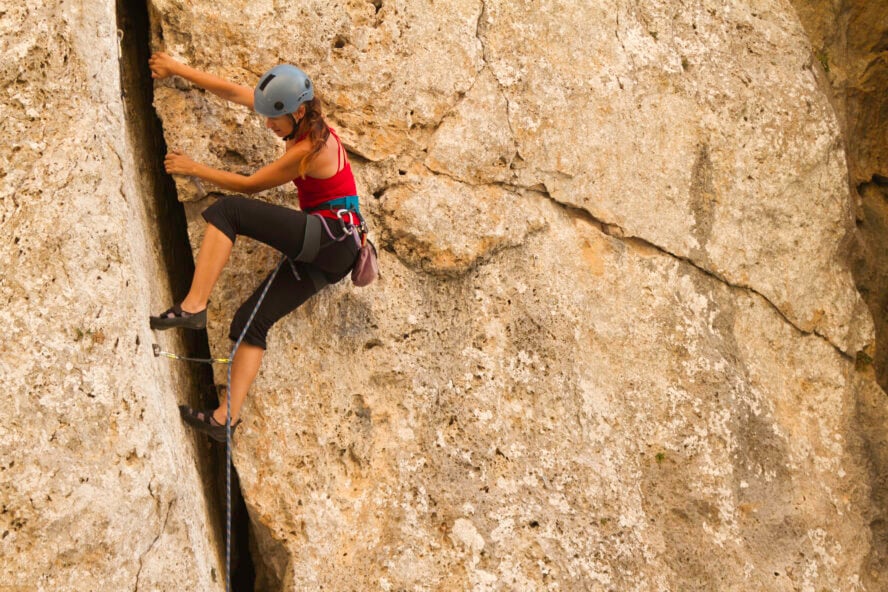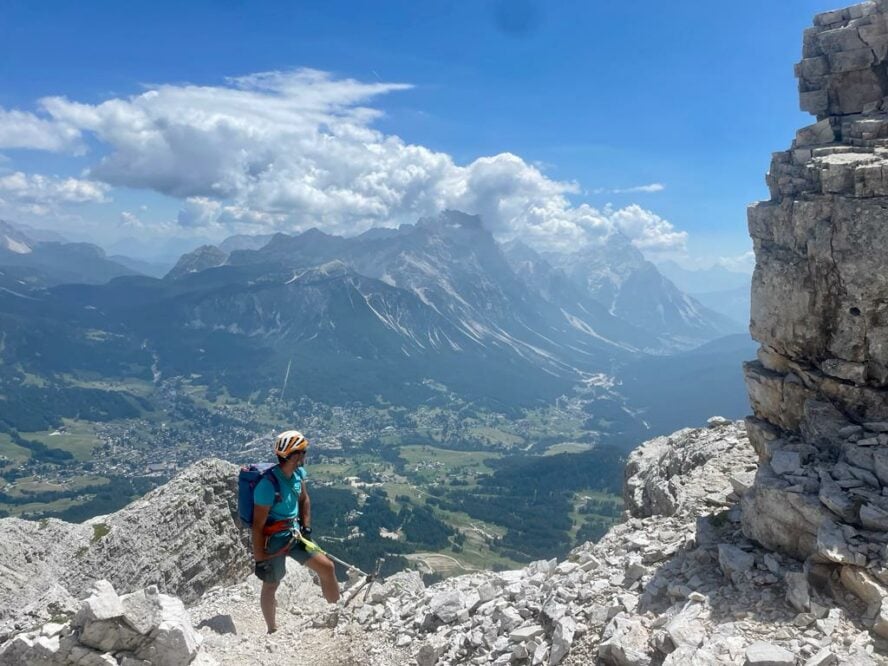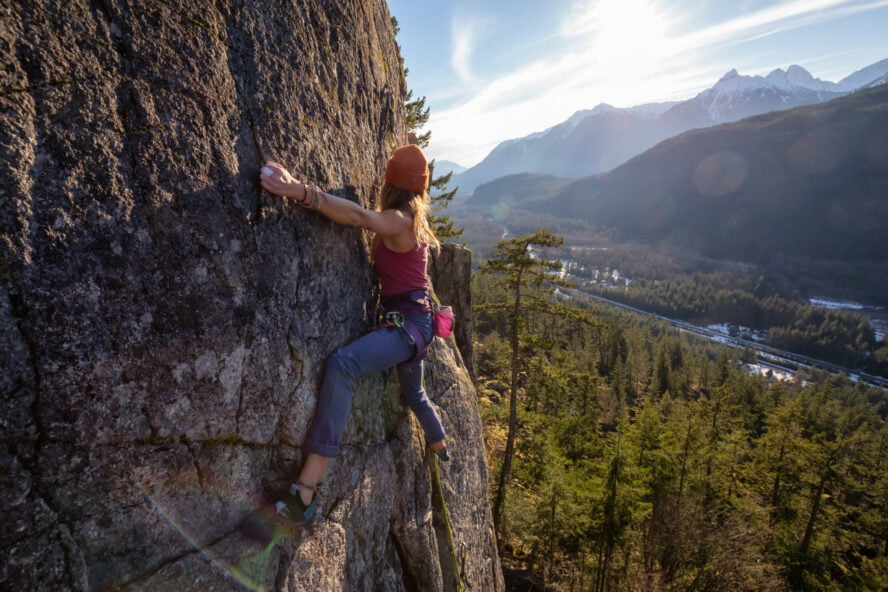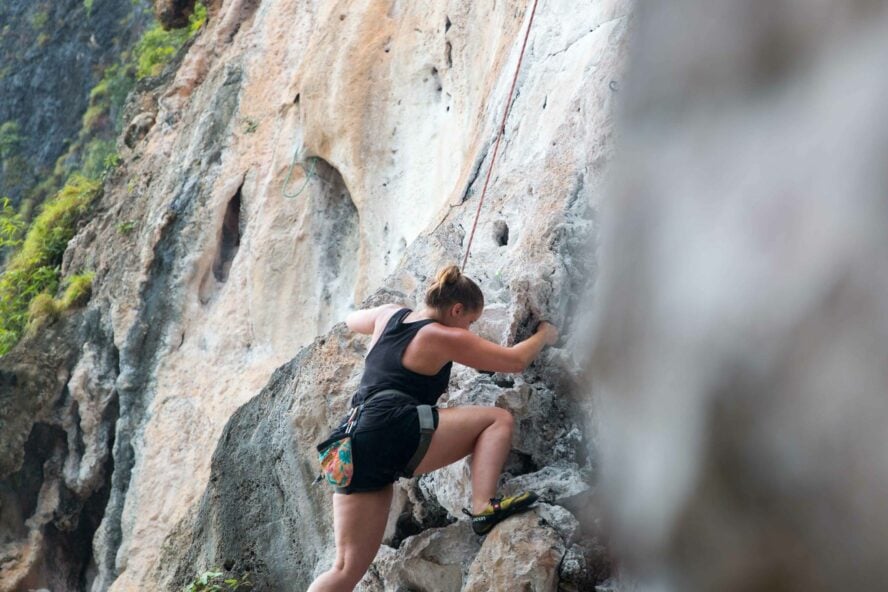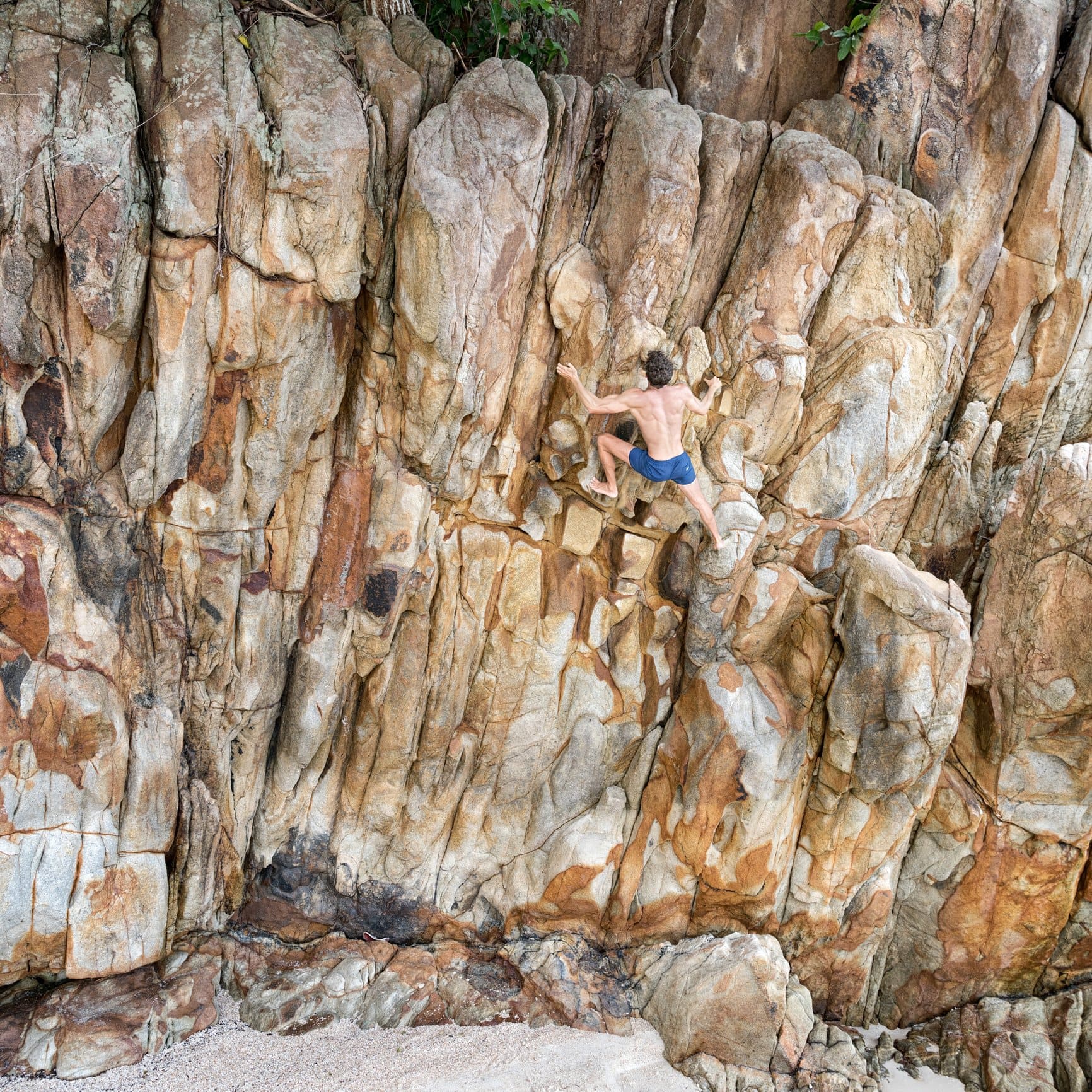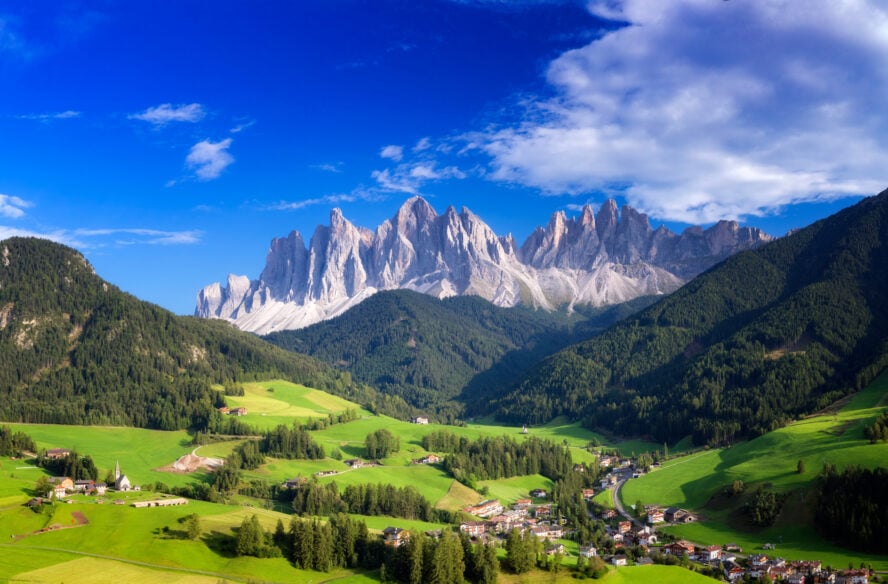Some climbers prefer sport climbing on perfect tufas with breathtaking sea views. Others will swear that perfectly smooth granite walls in picturesque forest landscapes are tops. Traditionalists will only acknowledge huge walls in alpine settings, while modern bouldering nerds will attest that slapping perfect sandstone slopers — think rock climbing in Utah — is the only way to go. Because of the varying disciplines, it’s hard pin down the absolute best states for rock climbing, let alone the best climbing spots in the world. But, if you tally up the favorites from all areas of the sport, you’ll end up with the list we have here — a selection of the very best rock climbing adventures you can find on planet Earth, no matter what your jam is.
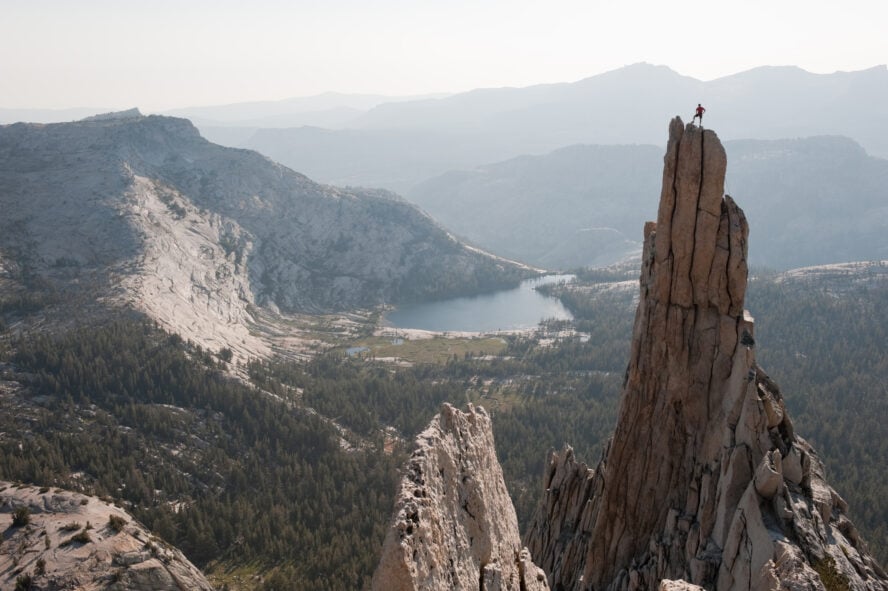
1. Yosemite National Park, USA
California is one of the best states for rock climbing, and while the climbing in Joshua Tree is well-worth an absolute honorable mention, there is hardly another climbing area in the world with as much history as Yosemite. Climbers used to call it the “Centre of the Universe.” Indeed, they were right. For generations, the world’s best climbers used to make the legendary Camp 4 their home. They would refer to themselves as “The Stone Monkeys” and spend their days either climbing or planning their next climbing feat. (Tip: Before booking a trip, do your homework and watch Valley Uprising). Yosemite was always at the forefront of the climbing world, and little has changed today — except regulations. If you are planning on becoming the next Stone Monkey of Yosemite (and who can blame you!), you’ll have a tough time persuading the park’s rangers that Camp 4 is your new address.
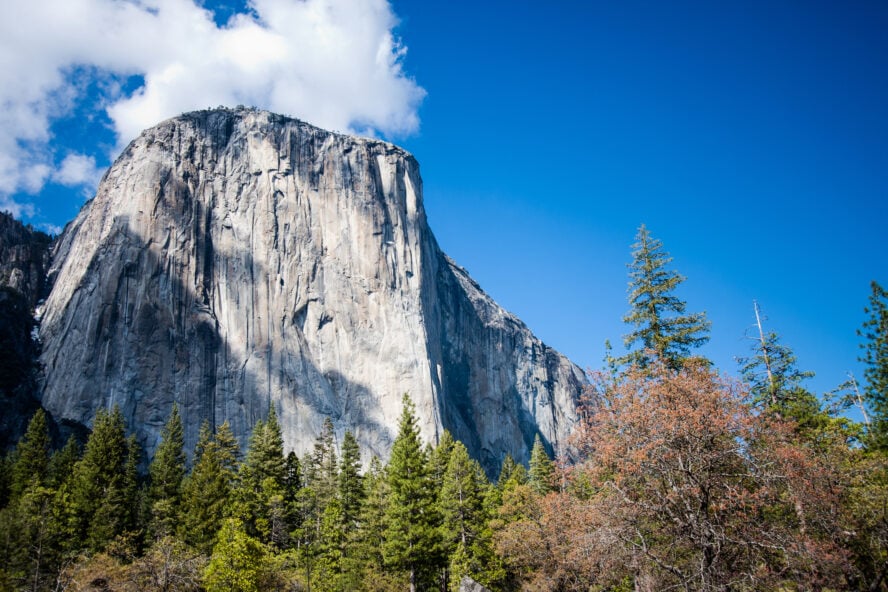
Exceptional granite, but tricky to climb
The love affair between climbers and Yosemite is, of course, not without good reason. Climbers love rock, and Yosemite offers a sea of incredible granite, with breathtakingly beautiful nature to boot. The mecca of rock climbing in California is crafted from some of the best granite you will ever find anywhere. The only problem is that it’s darn hard to climb on. Be ready to tackle microscopic footholds and smooth rock faces interrupted with splitter cracks as hand-friendly as the ones you’ll find rock climbing in central Mexico. I was taught that no matter how hard your limestone sport climbing grade is, learning to crack climb starts from the easiest grades up. I won’t even go into Yosemite’s off-widths, that’s a discipline for itself!
Before you commit to your big wall adventure, I’d recommend easing into the climbing style with some of the single pitch crags such as Swan Slab, Cookie Cliff or the Cascade Area. They’re as good as the ones you’ll find climbing in Red River Gorge, and the views are nothing to scoff at, either.
When you are in Yosemite, make sure to check out some of its breathtaking hiking trails too!
Yosemite’s world-famous routes
Most known for its huge granite walls, Yosemite’s bouldering is on par with the world’s best. Midnight Lightning (V8), the landmark of Camp 4, is arguably the most famous boulder problem in the world. Yosemite hosts many other world-renowned climbs. The Dawn Wall, with the mighty grade of 5.14d, is the hardest big wall climb. El Capitan — at 3000-feet-tall — is a top candidate for the most iconic rock climb of all time. I’ve yet to meet a serious climber (and I’ve met plenty) who doesn’t have El Cap on their bucket list. So, are you a serious climber?
Hard and challenging climbing in the most beautiful place in the world. Perfect mix for me.
By Viktor Marohnić — veteran climber and founder of 57hours
Yosemite National Park, USA - Good to Know
From intermediate to advanced and elite. Most routes require placing your own protection, friends, nuts, etc.
Spring and autumn
All the joys of slick granite: holdless slabs, splitter cracks, off-widths, chimneys, etc.
Most people fly to Oakland or San Francisco International airport, rent a car, and drive about 4 hours to Yosemite. It is also possible to reach Yosemite by public transport. Having a car makes your life easier, but it is not essential, many climbing sports can be reached by shuttle buses, biking or hitchhiking.
Yosemite sees thousands of climbers yearly, so it’s essential that climbers minimize their impact by following the park’s climbing ethics.
There is more to Yosemite than climbing. 4 million tourists visit it per year for a reason! There are plenty of things to do on the rest days, such as hiking and mountaineering.
The Pines Campground is a climber go-to, but make a reservation. Of course, every climber wants to stay in the iconic Camp 4, but securing a place there requires patience and luck. Note, there is a 30-night camping limit in Yosemite National Park, 14-nights from May 1 to September 15. Then there’s The Ahwahnee Hotel (formerly the Majestic Yosemite Hotel). It’s a Yosemite landmark, but it’ll cost you.
2. Kalymnos, Greece
Is there anything better than a perfect overhang, scattered with beautifully sculptured tufas, hiding all kinds of sport climbing trickery, like knee bars, deep drop knees, heel hooks and toe hooks? If you share my vision of a perfect sport climbing route, a rock climbing trip in Kalymnos is the ‘X’ on your treasure map. If you don’t share my vision, climb there anyways! The area is full of hidden climbing treasures. Kalymnos’ pumpy overhanging mega pitches are the island’s main dish, and its 3,400+ routes, ranging from slabs to roofs, are plenty to satiate any climber.

Come for the climbing, stay for the food, sun and sea
When you’re not rock climbing in Kalymnos, a Mediterranean diet of fresh fish, fruits and vegetables will feed your body, while beautiful scenery, sun and sea will feed your soul. The word on the street there is that the climbing grades will feed your ego, too…
Year-round climbing season
Kalymnos’ Aegean setting and its dry, Mediterranean climate makes climbing possible throughout the year. Autumn is the best and most popular season for climbing, with October being the month where the number of climbers peaks, so keep that in mind when planning your trip. If you choose to go in October, you may want to avoid Odyssey, Grande Grotta, Arhi and Spartacus, as they are the most popular and most crowded spots.
Where to make home base
Though Kalymnos is small, it offers everything you need to stay there. Most climbers choose the villages of Armeos, Masouri and Myrties as their base. From here, you can easily access all climbing spots by either scooter or foot. The island also has a number of hotels and studio rentals, bars and restaurants, and most importantly, gear shops and guiding services that offer great guided rock climbing tours in Kalymnos. Be aware, there have been a few reported cases of burglary. As is the case for climbing in Spain, it’s better to take your valuables (money, passports, etc.) with you when you leave for the rocks. And if you’d like some serenity and soul-searching to go with your climbing, a Kalymnos climbing and yoga retreat is the way to go.
With well-bolted crags and a wide variety of grades, the climbing in Kalymnos is accessible for climbers of all abilities.
Kalymnos, Greece - Good to Know
Amateur to pro, 4a to 9a (5.5 to 5.14d)
Fly to Kos, then take the ferry to Kalymnos, or fly to Athens, then fly directly to Kalymnos
Rent a scooter
Fatolitis Snack Bar in Masouli is a favorite post-climb spot
Snorkeling, scuba diving, hiking, cycling, cave exploring, relaxing on the beach
3. Dolomites, Italy
How does this sound? You get up before dawn (the excitement doesn’t let you sleep anyway), you force breakfast down, hike for two hours to the base of the wall, climb pitch after pitch of sketchy rock while clipping ancient rusty pitons. You freeze at the belay while your partner takes forever to find the next anchor. You race against the fading light, to inevitably lose and end up descending well into the night. Doesn’t sound like fun? Believe it or not, there are plenty of climbers that would sign up for an alpine adventure like this any day!
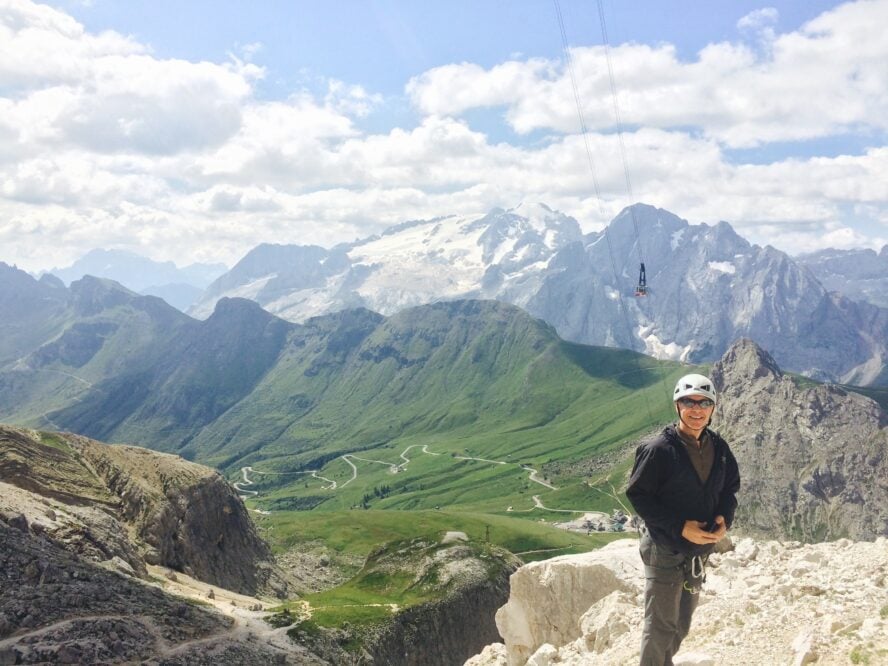
World-renowned alpine climbing
If you dream about a proper alpine climbing experience with approaches as short as in El Potrero Chico climbing, Dolomites are a place to go. What Yosemite is to the US climbing scene, the Dolomites is that for Europe — a proving ground for generations of climbers and one of the best places in the world for alpine climbing. While most climbs are slabby and vertical, there are some serious overhangs, such as the great roof of Cima Ovest. And, as is the case with rock climbing in Wyoming, when you happen upon a longer approach, you won’t mind — it just means more time to admire the scenery.
Climbing here is indeed amazing, but for me, what set the Dolomites apart from the rest of the places I ‘ve visited is the landscape. It’s fairytale-like. Green fields full of colorful flowers, the backdrop of the mighty snow-capped mountains, the omnipresent soothing of softly jingling cowbells. Whatever the Dolomites take in the form of challenging and often scary climbing (they make the run-outs from rock climbing North Carolina look like child’s play), they give back every time you remember to look around away from the rock.
Tre Cime, Cinque Torri and Marmolada South Face
The Dolomites, which span 80km east of Bolzano, contain numerous impressive rock spires, some resembling the ones you’ll find on Tantalus Range climbing expeditions, often topping more than 9000ft. My favorite of which is Tre Cime. The three 1500-foot walls are guaranteed to make your jaw drop, especially the great roofs of Cima Ovest, which host several 5.14b test pieces. Like climbing Devil’s Tower, sending any of these behemoths is quite serious business. And since finding descents is not always a trivial task in the Dolomites, getting off can prove to have its own set of challenges. If you’re up for the challenge, but would like the odds on your side, consider heading out on a guided rock climbing Dolomites trip.
For a more welcoming alpine experience, I would recommend an equally amazing but smaller set of towers named Cinque Torri. Of course, the 3000-foot wall of Marmolada South Face deserves a special mention. It is arguably the most impressive wall in Europe, and it requires equally impressive climbing skills. If that’s not enough, there are hundreds of sport climbing crags around.
Last but not least, there’s the Italian food! I know we climbers are always on a diet, but this is one place where you’ll want to give your calorie counter a holiday.
With a longer approach and fewer climbers, the Andrich route on the Torre Venezia , is one of the great spots for crack climbing in the Dolomites.
Dolomites, Italy - Good to Know
Beginner to pro. There are plenty of easy graded routes, but be aware that even for the easy climbs alpine experience is needed, such as route finding skills, placing protection, moving on sketchy terrain, etc. Make sure to inform very well about the route before embarking on a big wall adventure.
Summer, July to September. Note that even during the summer there are frequent rain showers, keep an eye on the forecast.
Technical climbing on dolomitic rock. Rock quality varies from a wall to a wall, but in general Dolomites are not known for solid rock. Always wear a helmet.
The best option is to fly to one of the nearby airports (Munich, Milan or Venice), rent a car and drive about 3-4 hours to the Dolomites. Given the size of the area, I recommend having a car to move around.
The Dolomites are a big area and there are many guidebooks covering specific parts of it. For a selection of best multi pitch and sport routes check The Dolomites – Rock Climbs and Via Ferrata Guidebook.
Nearby towns of Arabba, Canazei, Cortina, Corvara, Colfosco, and La Ville offer a number of refugios, guest houses, rental apartments, and camping sites.
As it often rains in Dolomites, it is worth knowing that the world-class climbing area Arco is just 2.5 hours away by car. There are also several excellent crags on the sea side around Trieste, about 3 hours away, such as Costiera, Val Rosandra or Napoleonica.
The Dolomites are the land of via ferratas. In winter, they’re home to the largest ski resort in the world. Hiking and mountaineering trips are simply breathtaking and will guide you through many historic landmarks. There are a number of museums, too (for climbing nerds, check out Messner Museum!).
4. Fontainebleau, France
When I first entered the forest of Fontainebleau, just 90km south of Paris, I felt like a kid on Christmas morning! I was stunned by all of the perfectly smooth sandstone boulders, and their incredible shapes, colors, and crazy “elephant skin” texture. I kept wondering how nature could have made this place? The best conclusion I could surmise was that the stone was here for a purpose: it was made to be conquered by climbers. Indeed, climbers divined the boulders’ some time ago.
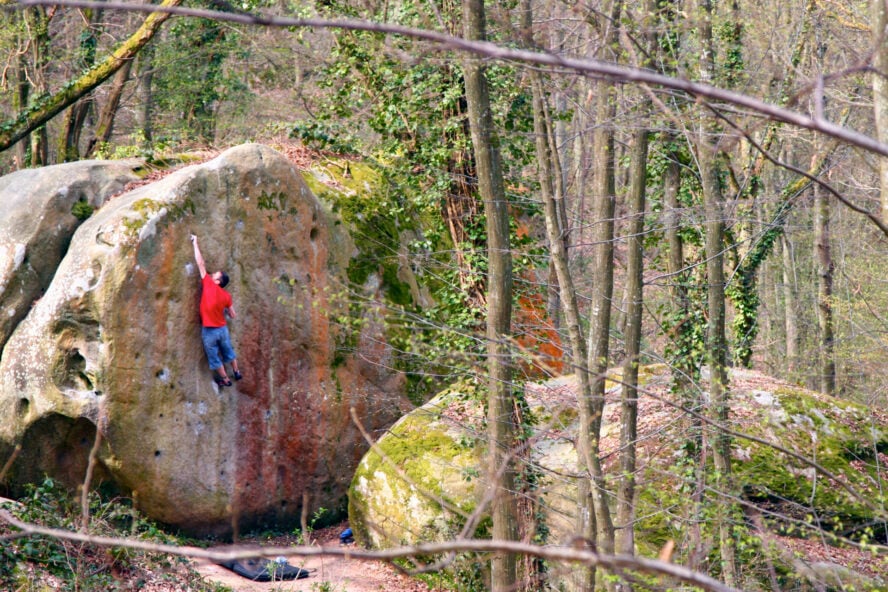
The birth of bouldering
Ever since the late 19th century, alpinists from Paris would climb Font’s boulder problems in succession (i.e., what we call bouldering circuits today) to prepare for bigger walls they intended to climb on future expeditions. This pastime later took off on its own, evolving into what we today call “bouldering” — arguably the most popular discipline of rock climbing. Even the grading scale used in bouldering is called the “Font scale.”
Family-friendly, with easy access
Fontainebleau (or simply Font or Bleau) is huge. The forest spreads out to over 900 square kilometers, with more than 100 bouldering areas and more than 30,000 registered boulder problems to test your skills. Most of the sectors are easily accessible, with short walks on flat terrain, and soft and sandy landings (check Cul de Chien sector!). My friends who have kids love to take their toddlers to Font, they can play in the sand while their parents crush boulders problems.
Known for: slopers and color-coded circuits
Font’s specialty are slopers — the area has the most perfect examples you’ll find anywhere. The climbing is tricky and technical, with some close to none-existent footholds in places. I believe anyone’s footwork will benefit from a trip to Font!
Another Font specialty is its color-coded circuits — the legacy of Parisian alpinists. There’s a circuit for every level, yellow circuits are for inexperienced climbers; orange, blue and red circuits for intermediate climbers; the white and black circuits are reserved for experts. Font is a must for every serious boulderer. Even if bouldering isn’t your cup of tea, Font could change your mind. It happened to me.
Font sandstone is simply the best in the world. Add history, unlimited potential and its proximity to Paris, and soon you realize it’s hard to find reasons not to visit.
by Perica Levatic, 57hours founder, rock climber, and speed champion
Fontainebleau, France - Good to Know
Go in spring and autumn for the best grip, summers can get hot, but due to the vast amount boulders there’s always shade somewhere
It’s good to have a car due to the size of the forest. Some sectors are accessible by public transport.
The are several camping sites, three hotels and a lot of Airbnbs in Fontainebleau and Gîtes, all of which are full of French character
From amateur to professional. Note that even easy boulders can be quite tricky to climb. Apparently Adam Ondra, the world’s best, fell off a 6A boulder!
Exhaustive online databases can be found at Bleau.info and BoulderFont.com
Because of Font’s size, there are lots of guidebooks: circuit guides, off-circuit guides, and mixtures of both. See this list of guidebook reviews for more info.
- Visit Paris
- Visit Château de Fontainebleau
- Disneyland Paris if you travel with kids
- Guided hiking tours through the beautiful forests, rent a bike and ride around, or even go for a carriage ride for a unique European experience
Karma is an excellent indoor bouldering space for all skill levels
5. Squamish, Canada
If I had to describe Squamish in a few words, I’d say: adventure at your doorstep. Only one hour north of Vancouver, it’s got everything an outdoor adventurer needs, including granite that will make Front Range climbing fans cry tears of joy. There’s intimidating, big walls, world-class single-pitch and bouldering, with both trad and sport climbing on offer.

Routes for all disciplines and skill levels
Few places have so many world-class routes between grades and climbing disciplines. Because of this and such easy access to so many crags, I find Squamish to be a truly unique place. The climbing here is on the finest slick granite, which means plenty of splitter cracks. There are classic crack lines of all grades — from 5.8 to 5.14. If you don’t have prior experience with crack climbing, be prepared to learn from the hard way. This is one of the places where it pays off to go with a guide, so consider a guided rock climbing day in Squamish. I have seen (and experienced first-hand!) climbers falling off cracks that are way below their usual sport climbing level. Finally, I have to mention the rain. It can be rainy in Squamish, but there has to be something, right? Otherwise, it would just be too perfect.
Climbing the Chief
Squamish’s most prominent climbing feature is the Chief, a mighty 700m granite wall that looms over the town. Climbing the Chief is a neat feather for your cap, but it will make you work for it. The easiest way up is only 5.9, but the route requires some efficiency to complete it before nightfall. I advocate starting with some of the smaller walls, like the Apron, to get a feel for the climbing and to practice moving quickly. There’s also easier routes up the Chief, and they’re quite popular, so I recommend an early start to avoid getting stuck in traffic.
Where to go for single-pitch routes and bouldering
For the best single pitch rock climbing in Canada, I’d recommend Smoke Bluffs, Murrain Park, and Leviticus, ordered with respect to the increasing level of difficulty. The forest below the Chief is littered with boulders. Even if Squamish is not primarily known as a bouldering area, don’t be fooled. Bouldering in Squamish truly is world-class, and the world’s best boulderers will attest to that. It is worth mentioning, the two gems of the area that attract the world’s climbing elite: Cobra Crack (5.14b), one of the hardest crack climbs in the world, and Dreamcatcher (5.14d), the most esthetic sport climbing line as far as I am concerned, first ascended by the legendary Chris Sharma.
If you’re looking for a more in-depth overview of climbing in Squamish, check out the review by former Squamish resident and climber Jase Wilson.
Squamish is the perfect climber’s destination. From the amazing sport climbing, to the bouldering, alpine climbing, single-pitch crack and multi-pitch trad climbing., it's really got it all.
Squamish, Canada - Good to Know
Bouldering, trad, multi-pitch, and sport climbing on slick granite of all grades. From beginner to pro (5.8/5a to 5.14d/9a)
From May to September. Summer months can get hot and are better for relaxed climbing
Fly to Vancouver and drive north for 1 hour. It’s a good idea to have a car, but you can reach Squamish by public transport or ride share.
The Stawamus Chief Provincial Park Campground offers simple campsites just below the climbing area (there are no showers). There’s also plenty of hotel and Airbnb options. The Squamish Adventure Inn is a popular choice for many climbers, and it’s just a short walk to many climbing spots.
Squamish Select by Marc Bourdon for single and miulti-pitch climbing. Also Squamish Bouldering, also by Marc Bourdon
Zephyr Café for a good coffee, tea and cake with fellow climbers; The Watershed Grill for sit-down dining or a post-climb beer.
The place is famous for mountain biking and downhill riding (be careful with the latter option!). There are many beautiful hiking trails, via ferrata, as well as options for kayaking, kitesurfing, sailing, and canoeing.
Try Cheakamus Canyon, a 20-minute drive from Squamish, or bail to Ground Up Climbing Centre for some indoor action.
6. Zermatt, Switzerland
In the Swiss Alps, right next to the Italian border, sits Zermatt — one of the most famous alpine towns in Europe. What makes it so great? The answer is simple: It grants access to 38 13,00-foot peaks. Zermatt is hands down one of the best places for climbers that aren’t afraid of crampons and ice axes. Admittedly, I’m not a part of this group, but I have great admiration for this breed of climber. The scenery around Zermatt is more than enough to justify a visit, but luckily for me, there’s also some fine bouldering and sport climbing around to feed my climbing soul.
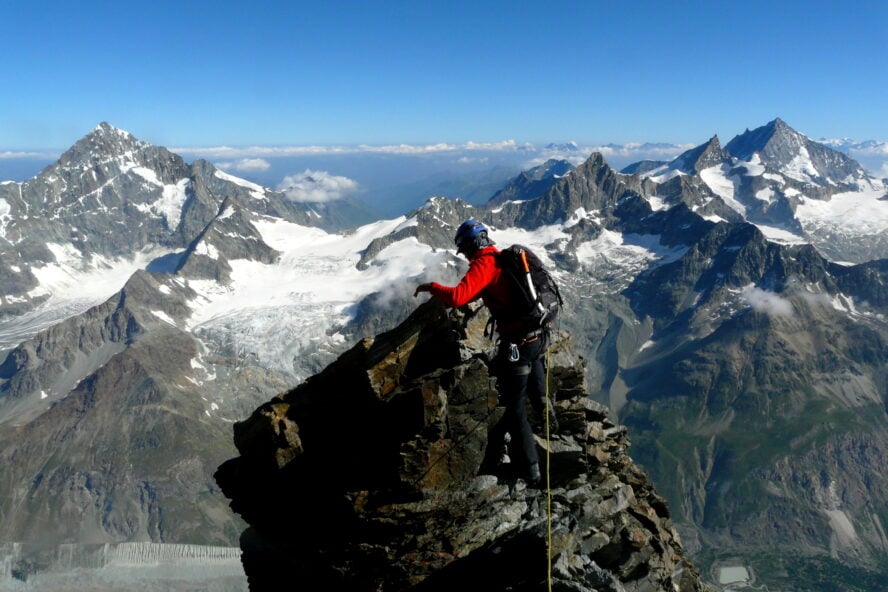
Climbing the Matterhorn is serious business
Climbing in Zermatt isn’t just about scaling rock faces, it’s a full-on alpine adventure involving crossing glaciers, high altitudes and complex logistics. Basic knowledge of alpine climbing skills is a must even for easiest routes. When people talk about climbing around Zermatt, there is one peak that steals all the spotlight. It’s the majestic Matterhorn, looming nearly 15,000ft above the city. Its mighty pyramidal shape makes it one of the most distinctive mountains in the world. Climbing the Matterhorn is a serious alpine endeavour. It requires the ability to move comfortably along exposed ridges, proper acclimatization and excellent physical fitness. Most people hire a guide; only seasoned alpinists do it alone.
Warm-up on the Riffelhorn
The Riffelhorn — AKA Matterhorn’s little brother — grants an excellent climbing experience for those not yet ready for the real thing. Sitting above the Gorner Glacier, it’s known as the peak with the best views: Monte Rosa on the left and Matterhorn on the right. Riffelhorn was used as a training ground for Matterhorn for decades; however, the steep bolted routes put up in modern times are excellent challenges in themselves. Leading through a series of steps, the easiest ways up are along the east and the west ridges. The south face offers clean vertical climbing up to eight pitches long, making it a perfect option for a day climb from Zermatt.
Zermatt is a unique and historic place, offering an amazing polygon for the modern climbing experience.
By Luka Krajnc — professional alpine climber
Zermatt, Switzerland - Good to Know
For intermediate to seasoned alpine climbers.
From June to September
Climbing involves a mix of snow and rock. The peaks are mostly composed of gneiss, with some mix of schist and other rock.
Your best bet is to fly to Geneva, Bern, or alternatively, Milan, and take the train to Zermatt (note that cars are not allowed there, only until Taesch). From there take Gornergrat Mountain Railway and get off at Rotenboden or Riffelberg stations.
Valais Alps West: Selected Climbs and Valais Alps East: Selected Climbs; and Schweiz extrem WEST 2010 for sport climbing.
There are many hotels and Airbnbs for recreational stay, but also mountain huts on the route to Matterhorn (many of them are open only during summer) both on the Swiss and Italian sides.
Note that Zermatt is one of the most expensive tourist destinations in Europe. There is a camping site close to the train station with manageable prices. Bring a camping cooking set. Gondolas are very pricey; the alternative to get to the mountains are lengthy treks.
7. Red Rock, USA
It’s almost absurd the polarity between the shiny human anthill of Las Vegas and the wilderness of the Red Rock National Conservation Area (aka Red Rocks). In the former, you’ll find flashing neon lights and 24-hour entertainment; just 20 miles away, you’ll find serenity among the rocks and climbing for all types.

Endless walls of red-striped sandstone rising from the Nevada desert are home to thousands of routes and boulders. You’ll discover a lifetime’s worth of climbing in Red Rock. From single-pitches to 2000-foot-tall multi-pitches, from bouldering to sport and trad climbing, Red Rock has it all. Combined with the dry, sunny conditions that match the climbing in Oregon, the beginner-friendly potential to rival Rumney climbing, and the amenities of the nearby metropolis, the place is hard to beat. It does not come as a surprise that many of the best climbers in the US chose to live in Las Vegas.
A great spot for beginner and indoor climbers
It is not only the quantity of the climbs in Red Rock, but the quality of them is notably remarkable. I find the perfect Aztec sandstone of Red Rock to be a gift to climbers. The “impossible” granite of Yosemite inevitably drives me nuts on occasion, and sketchy Dolomitic rock has given me a “what on Earth I’m doing here” moment more than once. But the abundance of nice in-cut holds at Red Rock is always a pleasure to climb on. There always seems to be a hand or foothold right where you need it. It’s definitely something to appreciate if you are a beginner or climb mostly indoors.
If you do head to Nevada to climb on this picturesque sandstone, make sure you know the local climbing etiquette in Red Rock and follow the guidelines.
From single-pitch routes that are bolted, to fully traditional routes, to sky-splitting, vertical walls 2000’ tall, Red Rock has every type of climbing under the sun.
Red Rock, USA - Good to Know
Beginner to intermediate for sport and multi-pitch climbing, and up to elite level for bouldering.
Winter for bouldering and sport climbing; Fall and spring for multi-pitches.
Superb sandstone with perfect in-cut holds. Warning: Do not climb during or after rain! Sandstone in Red Rocks is very fragile when wet; climb only when the ground is dry powdery sand.
Red Rock Canyon is just outside of Las Vegas, meaning plenty of cheap airfare. The entrance to the canyon is only a half-hour drive from the city, however, no public transport gets you all the way there so it is good to have a vehicle.
Red Rocks – A Climber’s Guide II by Jerry Handren and Southern Nevada Bouldering II by Tom Moulins.
Red Rock Canyon Campground is the only spot of camping around, and a reservation is necessary (up to 6 months in advance!). Other options are hotels and lodgings around Vegas.
Note that the use of 13-Mile Scenic Drive is limited to day use. In case you plan to climb long multi-pitches and expect to finish late, you have to buy a ‘late exit’ fee (in addition to the normal entrance fee). Also for certain routes it is possible to get an overnight permit. For schedule and additional details check this link.
Las Vegas is just around the corner – do we need to say anything more?
8. Rocklands, South Africa
Rocklands is a bouldering area three hours north of the oldest South African city, Cape Town. Miles and miles of perfect red and orange sandstone boulders are spread throughout the desert of the Cederberg Wilderness area.
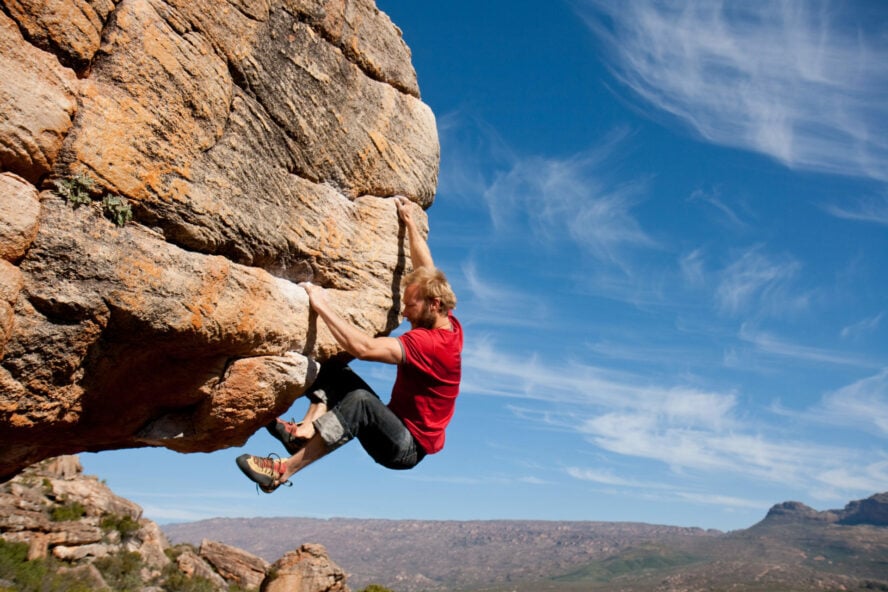
A modern bouldering mecca
If Fontainebleau is the birthplace of bouldering, Rocklands is its modern-day grandkid. The two areas complement each other perfectly. While Font is all about mastering the peculiar dance between bad and terrible holds, Rocklands is about steep athletic climbing, pulling hard, cutting loose, dynoing, campusing, locking off…all the fun stuff that’s part of modern bouldering! While I absolutely love Font, I go there with modest expectations, due to its particular style of climbing which is hard to learn anywhere else. The climbing in Rocklands, on the other hand, is more similar to what we climbers do on a regular basis at the gym. In Rocklands, I expect to send my hardest, which, I believe, is a reasonable expectation for anyone.
Bouldering legends, Todd Skinner, Scott Milton, and the one and only Fred Nicole, discovered the huge potential of the area in 1996. Two years later Klem Loskot, another old-school legend of the sport, quickly took up their excitement. In very little time, Rocklands became one of the top bouldering destinations in the world.
The best spots for bouldering in Rocklands
Bouldering is concentrated in three main areas: Pakhuis, Agterpakhuis and Wupperthal Commanage, though, new areas are developed almost every season. There are some sport and trad climbing spots as well. Even if it is not nearly as known as bouldering, I’ve heard of people traveling there being motivated solely by rope action. What adds to Rockland’s appeal is that it’s in the southern hemisphere, providing a perfect escape from the northern hemisphere’s summer heat. By the way, Fred Nicole still frequents Rocklands, alongside with many new climbing superstars. Opportunities for selfies with famous climbers always abound! And for rest days, South Africa hosts some of the best surfing in the world, so why not try it out?
Rocklands is cool because it's wild. You get amazing climbing far away from civilization on perfect red rock.
by Jernej Kruder, professional climber and bouldering overall World Cup Winner 2018 & World Vice Champion 2014
Rocklands, South Africa - Good to Know
Intermediate to professional (V6/7A to V16/8C+)
Fly to Cape Town, rent a car, then drive about 3 hours
South African winter: June to September
There are several guesthouses and a campsite. Book months ahead, lodgings fill up fast!
While this holds for every place you visit, Rocklands bouldering is located within the protected Cederberg Wilderness Area. Pack out all thrash and respect nature.
Most Rocklands areas require a climbing permit. You can learn more about obtaining a permit here.
Learn more about climbing in Rocklands from 27crags.com
Hiking and wine tasting are close by, but drive a few hours, and you’ll be on safari in Namibia or surfing on ocean waves from the coast
Rocklands Bouldering Guidebook by Scott Noy or 27crags App
9. Tonsai and Railay, Thailand
No matter how serious I am about climbing, I find that a laid-back style suits me best. Endless morning coffees, late arrivals, short approaches, napping between climbs, doing a few climbs, finishing early to go to a beach or a bar…you get the picture? Now, imagine all that, but with a breathtaking beach in an exotic location — that’s the kind of climbing you’ll find at Tonsai and Railay.
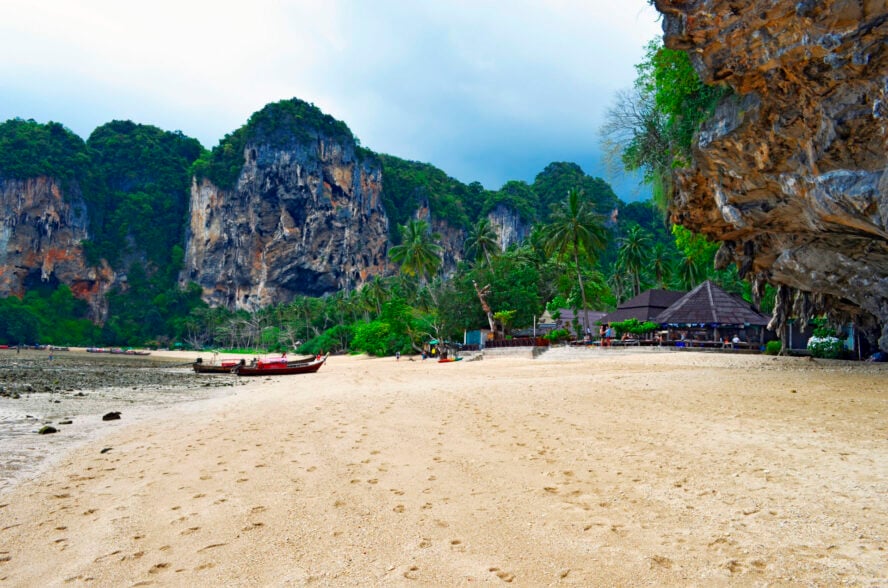
The quintessential climbing holiday spot
There’s perfect, overhanging walls directly above this sandy beach, and a bar directly below, full of fellow climbers. Can you imagine a better location for a relaxed climbing holiday? I can’t. This “beach” that I just described is really two climbing spots near Krabi in Thailand: Tonsai and Railay. During the climbing season, these two areas are transformed into a friendly community of like-minded climbers and hippies from all over the world.
In Tonsai and Railay, camaraderie and ease sum up the way of life when visiting. If traveling solo, finding a climbing partner is as easy as it gets, just show up at the bar. There are also plenty of guided climbing tours catered to your skills, guides, and rent-a-partners. The specialty (besides feeling like you’re climbing in paradise) is 3D climbing on stalactites. Lots of fun! For an unforgettable experience, I recommend one of the breathtaking multi-pitches on Thaiwand Wall.
It’s affordable and not too crowded… for now
Since Tonsai and Railay are popular tourist destinations, finding accommodation that suits your needs will not be an issue. The most typical type of arrangements are bungalows, though, the region has it all, from camping sites to hotel resorts. Decide if you would rather be closer to Railay or Tonsai and start planning from there. To add to the appeal, once there, you’ll find most everything quite affordable.
The area is increasing in popularity, and prices are steadily rising. I’d recommend visiting before this gem hits the mainstream. Anyone who’s ever tried rock climbing Washington knows the joy of finding a primo, crowd-free route. Due to logistics, climbing in Tonsai and Railay comes with a higher price tag, so check out our tips below to prepare better.
Tonsai is one of the only places on this planet where you can find an amazing tropical beach mixed in with world class climbing. It is literally one of a kind place that every climber needs to experience!
by Jacob Bushmaker, traveler and climber, author of the Tonsai Climbing – The Ridiculously Excellent Guide
Tonsai and Railay, Thailand - Good to Know
Beginner to advanced (up to 8c/5.14b)
Most routes are overhanging on pocketed limestone with many stalactites. It is possible to find some slab climbing
Fly to Phuket or Krabi (better option), take the bus to Ao Nang, from there a boat takes you to Tonsai or Railay
November to March (high-season) and April to October (low season). Expect queues in popular routes during high season!
Besides climbing there are plenty of other activities like yoga, snorkeling, kayaking, hiking, slacklining…
Some crags are only accessible by boat or during low tide, check the tide-forecast
The Pocket Guide by Sirichai Pongsopon
Exotic animals abound, like monkeys, scorpions, snakes, and lizards. Check cracks for possible guests if you are climbing some less traveled routes
Stock up on mosquito coils and sprays in Ao Nang. Mosquitos abound, beware of tiger mosquitoes, as they can transmit dengue fever. They are generally active only just before sunrise and after sunset
Climbing accessories such as chalk and tape can be expensive, so bring some with you to save money. Also, a large rope pad is very handy as sand gets everywhere
Check the condition of bolts and slings before you clip them! Due to the areas’ proximity to the ocean, many routes need re-bolting with expensive top-quality titanium bolts. If you can, donate to the re-bolting efforts at local climbing shops
It’s not drinkable. Buy bottled water









